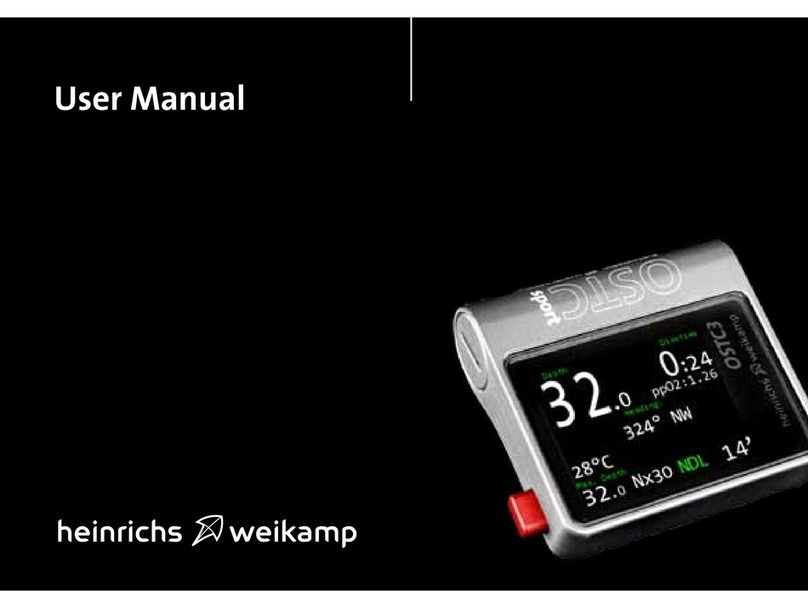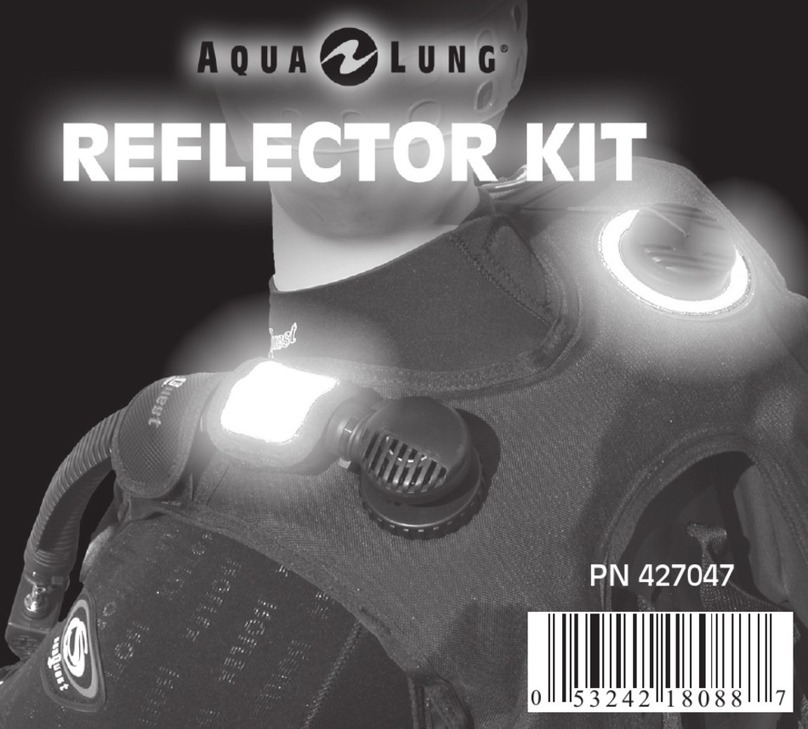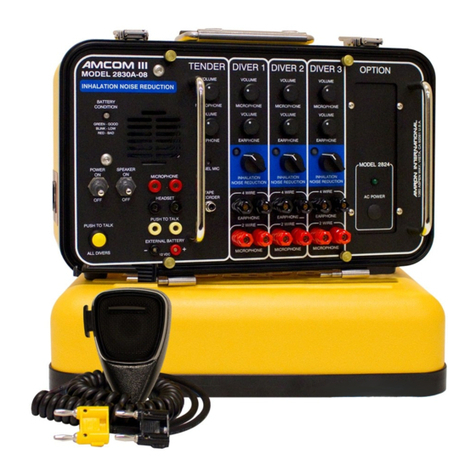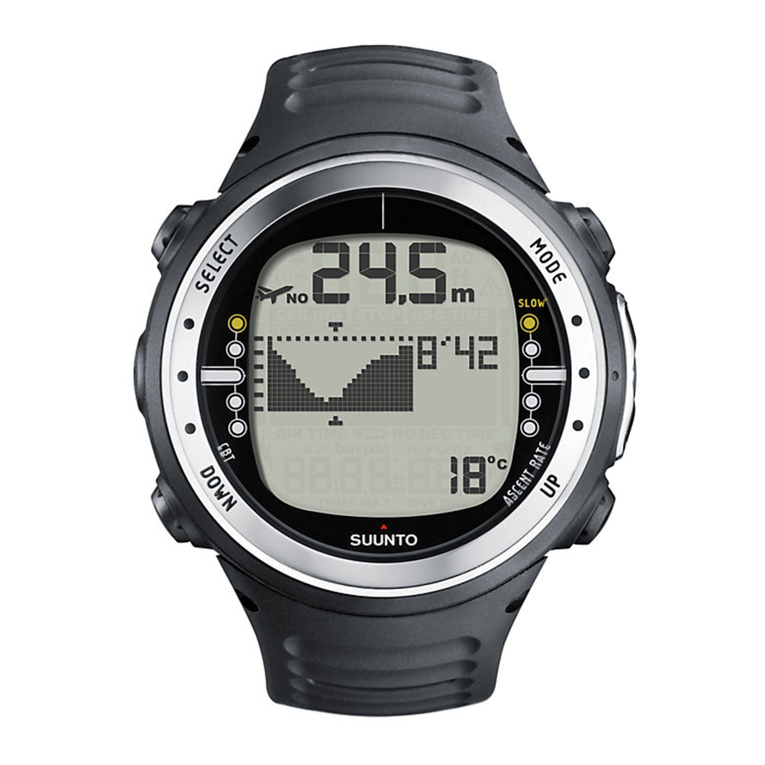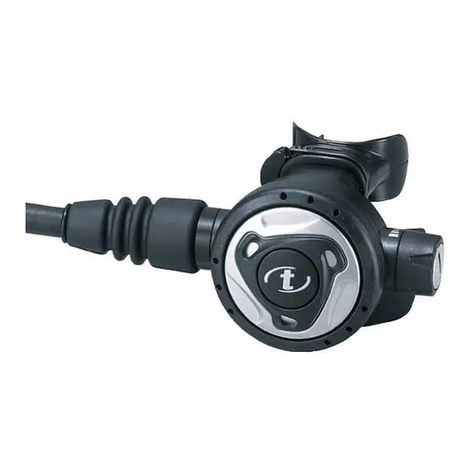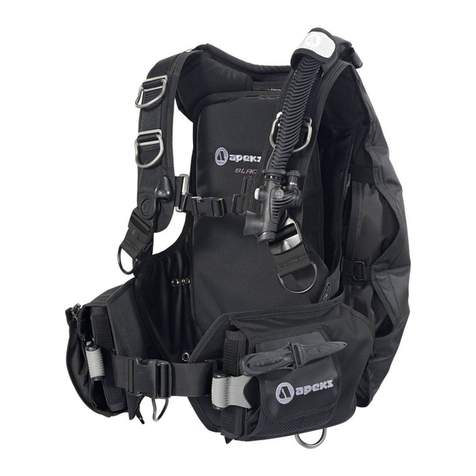Logic SENTURY Setup guide

Sentry Manual Rev2.1 Copyright 2017, Nellis Engineering, Inc.
SENtry
SENtrySENtry
SENtry
DPV Dashboard Installation and
Operator's Manual

Sentry Manual Rev2.1 Copyright 2017, Nellis Engineering, Inc.
2
Table of contents Page
Installation 3
Operation 6
Batteries and Charging 8
Dive Planning 9
Battery Life Calculation 9
Warranty 0
Warnings & Cautions
WARNING
A warning means that injury or death is possible
if the instructions are not obeyed.
CAUTION
A caution means that damage
to equipment is possible.
Note
A note is added to give more
information, usually in a procedure.
WARNING: Never allow the batteries to charge unattended or attempt to charge damaged
batteries. The Lithium Ion batteries have a high energy density and can catch fire or explode if
abused or damaged. Only recharge in a safe location, free of flammable materials, under direct
supervision and only using the supplied charger.
WARNING: Do not leave the batteries (alone or installed in DPV) in direct sunlight or a hot car.
Temperatures of 60°F (70°C) or above can damage the batteries resulting in fire or explosion.
WARNING: Do not attempt to charge the batteries when they are at or below freezing
(32°F/0°C). Permanent damage to the batteries will result, decreasing both battery safety and
capacity. While the outside of the batteries may be above freezing, the centers may not. Ensure
ample time is spent in a warm environment for thermal equilibrium across the pack before
charging, following exposure to freezing temperatures.
CAUTION: Avoid running the DPV until battery cutout. Deeply discharging the battery shortens
the battery life and can lead to over-discharge of the batteries. Should the DPV be run until cutout,
remove the recharge plug cover on the nose of the DPV after exiting the water and recharge the
batteries at your earliest opportunity.

Sentry Manual Rev2.1 Copyright 2017, Nellis Engineering, Inc.
3
Installation
The internal transmitter is held in place inside the DPV with adhesive hook and loop faster tabs
stuck on the inside wall. There is an attachment placement on the top inside wall of the tube, for
the transmitter antenna and an attachment placement on the bottom inside wall for the water
detector and reed power switch. Clean the inner diameter with alcohol or acetone if necessary, so
the adhesive will stick. The long Velcro strip containing the antenna of the transmitter should be
positioned as shown, approximately 2-3 inches from the rear edge of the tube. Peel off the backing
of the three short pieces of hook material, to expose the adhesive, and affix it to the upper inside
wall of the tube in an arc as shown in (Fig. ) Two outer pieces of hook strip attached to the inside
wall to support the each end of the antenna will require removal if the batteries ever need to be
removed from the body.
For the water detector, measure .3” into the tube at the bottom from the opening edge and
place a temporary mark with a pencil or piece of tape. Ensure the two short hook tabs are
attached to the water detector loop strip, peel off the backing of both hook sections to expose the
adhesive and affix it to the bottom inside wall with the wire exiting to the left, so the hook tabs
will not interfere with battery removal, (Fig. 2) The rear edge of the hook tab should be at the .3”
mark and the water detector further inside. This will place the reed switch used to turn on the
transmitter, 2.3” from the tube opening. The wires should exit to the left as shown.
Fig. Fig. 2
Place a mark on the outside of the tube 2.3” from the end of the tube and directly outside the wall
from the water detection board. (FIG. 3) Wrap the mounting strap for the Sentry external display
around the tube. Pass the end of the strap through the bungee loop and pull it back, stretching
the bungee and affixing the hook and loop faster together. Position the strap so that the gray
block that slides on the bungee, stops against the strap and over the mark, which is directly
outside the tube from the water detection board. The gray block contains a magnet to activate
1
.
3
”

Sentry Manual Rev2.1 Copyright 2017, Nellis Engineering, Inc.
4
the reed switch of the internal transmitter and is how you turn off the transmitter when not in use.
This will position the display about 2.0” from the end of the tube as well. If reception is
intermittent, position the display as far towards the rear as possible.
Fig. 3
Label the connectors on the tail of the Genesis with self adhesive labels as shown in Fig. 4
Fig. 4

Sentry Manual Rev2.1 Copyright 2017, Nellis Engineering, Inc.
5
Fig. 5
The loop fastener strip on the transmitter (Fig. 5) covers the antenna. DO NOT CUT IT!
Label the connectors on the batteries with self adhesive labels as shown in Fig. 6 & 7. Your battery
with serial number ending in - will have a small connector coming out of the larger connectors for
the transmitter power. (If it does not have this small power connector, you will need to attach one
by soldering the leads to the respective larger battery connectors.) Wrap the label with the “ ” on
each end around the yellow wire of this battery as shown in Fig. 6.
On battery ending in serial number -2, slide the red connector housing off of the white connector
housing and wrap the label with the “2” on each end around the yellow wire of this battery as
shown in Fig. 7. Connect the red wire from Battery -2 to the short lead coming from the
transmitter and connect the long lead from the transmitter to the white and black connector
housings of battery -2 as shown in Fig. 8. Finally, connect the small two wire connector from the
# battery to the transmitter. This can be done without removing the batteries from the tube as
shown, which was done for clarity. Clean and grease the seals on the DPV as usual before closing.
Affix the transmitter to the inside top of the tube and the water detector to the inside bottom of
the tube, then connect the battery connectors to the tail followed by the 6 pin circular connector
and close the DPV as normal, being careful not to pinch any wires.
Fig. 6 Fig. 7

Sentry Manual Rev2.1 Copyright 2017, Nellis Engineering, Inc.
6
Fig. 8
Operation
To wake the display, tap the left or right side of the display housing three times slowly. Tapping
too fast will not be recognized, to discriminate from vibration. In the bottom right corner of the
display (Fig. 9), it will display “UNIT ” for 0 seconds. To change the depth reading between Feet
and Meters, you must tap the side of the display 5 times within this 0 second window. Each
registered tap will be show on the display by a small dot near the center of the screen. The setting
will be saved for all further dives, unless changed again at start up.
At the bottom of the display, next to the display’s battery gauge, a series of vertical bars will
appear, indicating the signal strength from the internal transmitter. More bars equal better signal
strength, which can be used for positioning the display. In air and fresh water, the display should
have 0 bar most of the time, but in salt water, the RF signal is attenuated and fewer bars may be
displayed. If the bars are blinking, that indicates that the display is not linked up to the internal
transmitter. 3-4 bars are normally the minimum for establishing a link to the internal transmitter.
It may take 0-20 seconds once you have 4 or more bars, for the display to establish a link.
Moving the display slightly towards the rear of the DPV should increase signal strength. Ensure
the gray block sliding on the bungee is positioned so that it is directly outside of the water
detector on the inside of the DPV tube. Sliding the gray block up will disable the transmitter when
not in use and this must be done when removing the nose plug from the Genesis to disable the
motor controller during storage.
CAUTION
Leaving the transmitter powered while in storage will slowly discharge the #1 DPV battery,
leading to permanent damage of the #1 DPV battery, if allowed to over discharge.

Sentry Manual Rev2.1 Copyright 2017, Nellis Engineering, Inc.
7
To turn the display off, tap the side of the housing 3 time. In the lower left corner “OFF?” will
appear to confirm that you want to turn it off. (Fig. 0) Tap the side 3 more times within 5
seconds to turn off the display.
Fig. 9 Fig. 0
Depth (top left corner): Displays the depth in feet or meters with 0. unit precision. The depth is
compensated for altitude, provided the display is turned on before entering the water. If the
display is turned on while under water, it will revert to standard sea level calibration. The depth is
accurate to 425ft ( 30m) and accuracy may decrease slightly when below that. The Sentry housing
is rated for 660ft (200m),
Timer (top right corner): When the display exceeds 3ft ( m) depth, the timer in the top right
corner will start running and continue to run, until the depth reads less than 3ft ( m). The timer
will reset if the depth reads less than 3ft ( m) for 3 minutes.
Watts (center left) Displays the power that the motor is currently using in real time. The diver can
control the DPV to limit the power to that is required by the dive plan. By referencing a known
distance over a time period, the diver can estimate their speed based on the DPV power level for
their equipment configuration. More drag (i.e. drysuit, more tanks or towing articles) will require
more power to obtain a known speed and less drag (wet suit, single tank) will require less power
to achieve the same speed.
Watt-Hours (center right) Displays the quantity of energy consumed from the battery(s). It will
begin counting up from zero and the closer it gets to your known battery capacity, the closer you
are to swimming your DPV back to the boat or shore, and no one wants that. Do not turn off the
display until you are done diving for the day. When the Sentry is powered off, the Watt-hours
used are reset to zero on restart.
It is initially recommended to fully charge your DPV battery and dive the DPV with the Sentry
until your battery cuts out, to know the true capacity for future dives. Do this in good conditions
and near your exit point or boat, when you get close to what you believe your battery capacity is.

Sentry Manual Rev2.1 Copyright 2017, Nellis Engineering, Inc.
8
As an example, if you DPV has a 600Wh battery when new, and it is now 3 years old, you should be
near your exit at by around 450-500Wh consumed for this test and finish off the battery within a
short swimming distance of your exit.
Voltage V1 & V2 (lower left & right) Displays the voltage of each battery in a Genesis or other DPV
with 2 batteries in series or a single battery at V for DPVs with a single battery or two or more
batteries in parallel. This can be used to identify if battery voltage is dropping unexpectedly and
adjust your dive accordingly. You should have a rough idea of the normal voltage range of your
DPV batteries to determine if they are not performing normally.
Genesis DPV battery capacity based on resting voltage
(i.e. motor not running)
Battery icon (bottom center) The battery icon displays the charge level of the Sentry display. You
should have approximately 8-24 hours of battery life. When the DPV is not being used, the OLED
display will go into standby mode and flash “Standby” on the screen. When DPV power is
increased above 0 watts, the display will wake up and operate normally. Tapping the side of the
housing will also wake the display from standby.
Water intrusion When water is detected inside the DPV, the display screen, which is normally
black background with yellow lettering will flash alternately to yellow background with black
lettering and H2O display left and right of the tap indication dots. This will be very obvious and is
not a good thing, but while your DPV is still running, your DPV should exit the water as soon as
possible (deco obligations permitting). The water detector inside requires a very small amount of
liquid water to activate and will remain activated until completely dried. If water reaches the
transmitter, it will stop transmitting, at which point your DPV will likely also be very negatively
buoyant.
Batteries and charging
The Genesis DPV batteries can be recharged normally through the connector on the nose of the
DPV, no changes need to be made to that procedure. The Sentry transmitter and display can be
operated while recharging the DPV to monitor the charge voltage. Additionally the Sentry Display
can be recharged while on or off. The battery icon will change to show a small lightning bolt
through it when connected to the charger and should take 90 minutes or less to fully charge. To
install the charger on the display, line up the two screw heads on each end of the serial number
with the contacts on the charger clip, and then press the clip onto the display so it reaches over
the opposite side window. (Fig. )
100%
33.6V
50% 30.5V
90% 32.7V
40% 30.2V
80% 32.0V
30% 30.0V
70% 31.4V
20% 29.6V
60% 30.9V
10% 29.0V

Sentry Manual Rev2.1 Copyright 2017, Nellis Engineering, Inc.
9
Fig 11
Dive Planning
Dive planning using the Sentry requires a bit of math, just like breathing gas planning, but nothing
serious. As an example, if your dive plan calls for 90 minutes ( .5hrs) of run time, and you have
600Wh of battery, you should first reserve one third for contingencies, similar to the rule of thirds
for breathing gas. That leaves you 400Wh to use over .5 hours. 400 Watt-hours divided by .5
hours equals 266 Watts of power as the average power level for the entire dive. If you stay at or
below 266 Watts on average during the dive, that is the fastest you can go on that 90 minute dive
without cutting into your reserve. If by your previous dive experience you know that 260W results
in roughly 80 ft/min, that gives you… 45 minutes outbound, multiplied by 80 ft/min equal
8 00ft or .5 miles of range. (5280ft/mile)
Battery Life Calculation
As batteries age, they lose capacity and become less safe due chemical to changes inside the cells.
The decrease in capacity should be monitored to know when it is time to replace a rechargeable
lithium ion battery. When a rechargeable lithium battery has less than 70% of the original capacity,
it should be replaced for safety reason. By using the watt hours consumed and battery voltage it is
possible to estimate the decrease in capacity of the battery to determine when the DPV battery may
be due for replacement. This can be done during normal operation of the DPV as follows, if you
start with a fully charged battery.
At the end of your diving day, note the Watt-hours consumed and the voltage(s) of the battery(s).
Calculate what percentage of the original capacity that you have used. Actual used capacity for the
days diving (example 450Wh) divided by the original capacity of 600Wh when new…

Sentry Manual Rev2.1 Copyright 2017, Nellis Engineering, Inc.
10
450Wh/600Wh = 75%
Using the chart of battery voltage vs. capacity for your battery, find your ending voltage (for this
example well say the Sentry is reporting 29.2 volts) At 29.0V you should have a bit over 0% capacity
remaining, plus the 75% you consumed during your dive, gives you an estimate that your battery
now has a bit over 85% of the original battery capacity.
Warranty
The Sentry DPV Dashboard has a year limited warranty on all materials and workmanship
provided by Nellis Engineering Inc, when used for their intended purposes under normal conditions,
with the following exceptions.
. Water damage to the internal transmitter unit is not covered under this warranty.
3. The battery charger is not covered for water damage.
4. Structural or cosmetic damage from abuse or corrosion is not covered.
5. Nellis Engineering, Inc. will not be liable for any loss, damages or expenses, to include
incidental, special, consequential or collateral damages, arising directly or indirectly
from the sale or use of the equipment.
THIS WRITTEN WARRANTY IS THE SOLE WARRANTY AND SUPERSEDES ALL OTHER EXPRESSED OR
IMPLIED WARRANTIES, INCLUDING WARRANTY OF FITNESS OR MERCHANTABILITY, TO THE EXTENT
PERMITTED BY APPLICABLE LAW. SHOULD AN IMPLIED WARRANTY BE REQUIRED BY LAW, IT IS
LIMITED TO THE DURATION OF THIS WRITTEN WARRANTY.
To receive warranty repair, contact the factory for an RMA number prior to returning any
equipment for repair. All shipping charges to and from the factory are the responsibility of the
equipment owner.
Table of contents
Popular Diving Instrument manuals by other brands
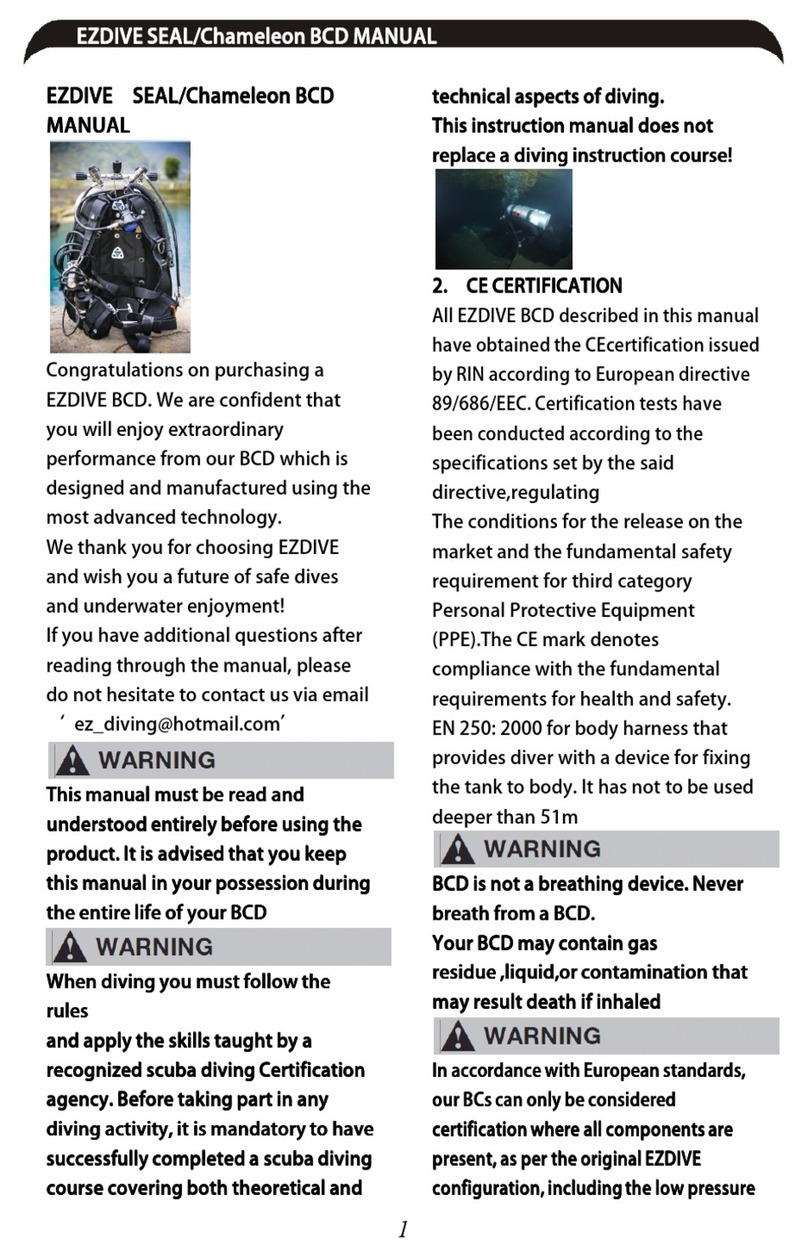
Easydive
Easydive EZDIVE SEAL manual
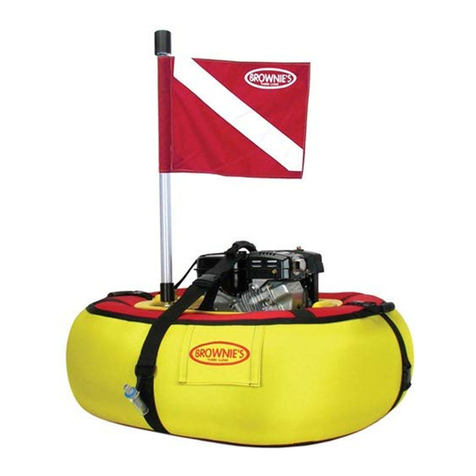
Brownie’s
Brownie’s THIRD LUNG Floating Series owner's manual
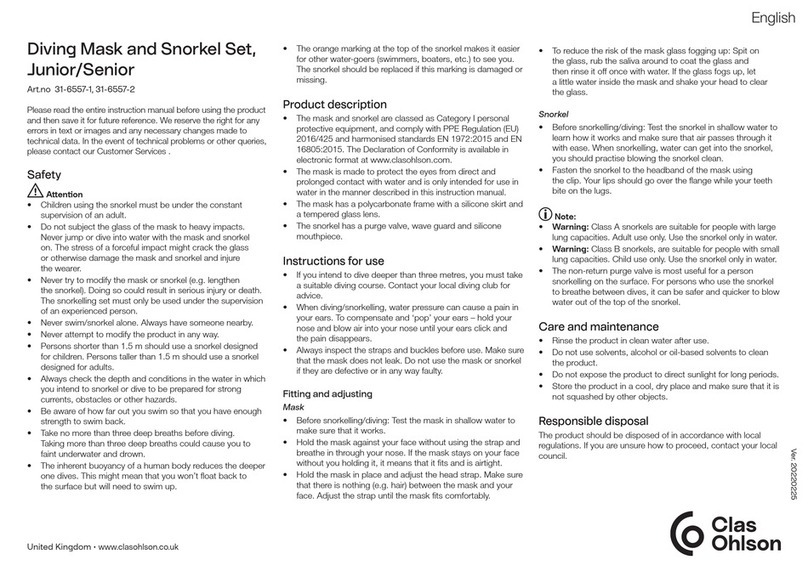
Clas Ohlson
Clas Ohlson 31-6557-1 quick guide
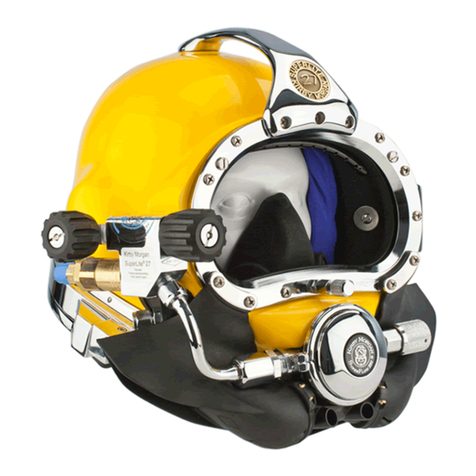
Kirby Morgan
Kirby Morgan SuperLite 27 Operation and maintenance manual

Sherwood Scuba
Sherwood Scuba SR2 Service manual

Kirby Morgan
Kirby Morgan 525-100 quick start guide


